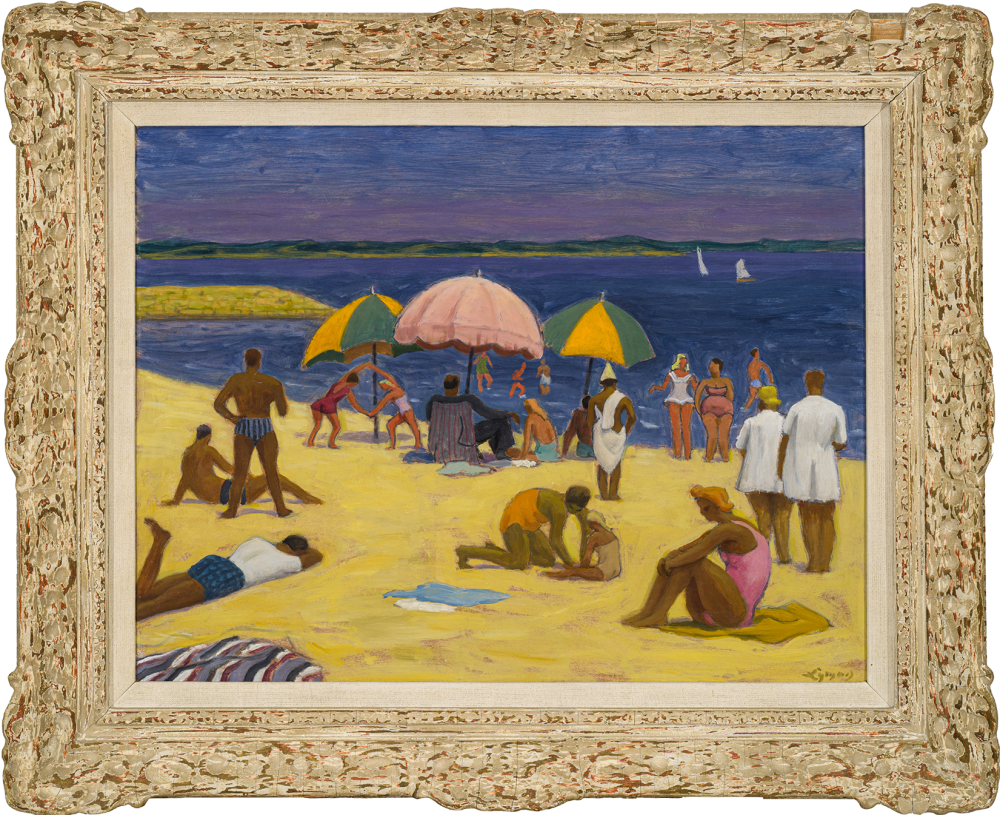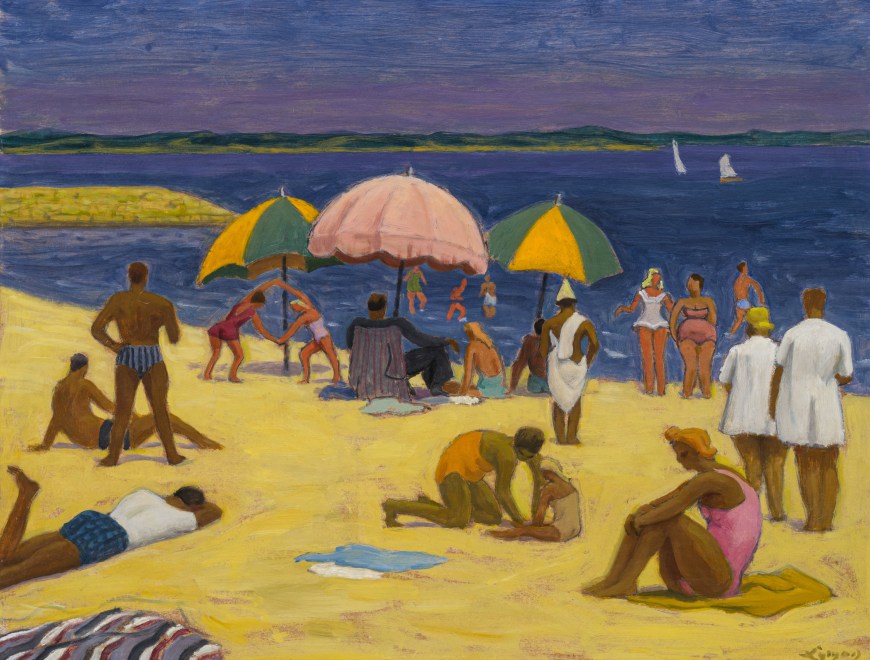50.8 x 66 cm
Inscriptions
signed, ‘Lyman’ (lower right)Provenance
Dominion Gallery, Montreal, March 1956, Inventory No. D2050
Acquired from the above in February 1958 by Alan O. Gibbons, Ottawa
Heffel Fine Art Auction House, Fine Canadian Art, 23 May 2007, lot 183
Property of a Distinguished Montreal Collector
Exhibitions
Quebec City, Musée national des beaux-arts du Québec, Morrice and Lyman in the Company of Matisse, 8 May 8- 7 September 2014; Kleinburg, Ontario, McMichael Canadian Art Collection, 4 October 2014- 4 January 2015, cat. no. 112.
Literature
Guy Viau, "Paroles de Peintre", Cahier d’Essai no. 2, January 1960, p. 25 - 27.
Louise Dompierre, John Lyman 1886 - 1967 (Kingston: Agnes Etherington Art Centre, 1986), similar works entitled The Beach, St-Jean-de-Luz reproduced page 138 and The Beach, St-Jean-de-Luz II reproduced page 139.
Michèle Grandbois, Lucie Dorais, Richard Foisy, François-Marc Gagnon, Marc Gauthier and John O’Brian, Morrice and Lyman in the Company of Matisse, ed. Michèle Grandbois (Richmond Hill: Firefly Books Ltd, 2014), 204, 247 [reproduced].Publications
John Lyman, Peintre, directed by Fernand Dansereau (Office National du Film du Canada, 1958), 30 min.John Lyman, Beach Scene - La Grande Plage
by Michèle Grandbois
Beach Scene - La Grande Plage emerged from the shadows of the private sphere with a brief appearance in Je vis par les yeux, a National Film Board of Canada documentary broadcast on Radio-Canada in 1958 and produced as a film in 1959. [1] It only reappeared half a century later at a Heffel auction in 2007. In the most complete work on John Lyman, Louise Dompierre mentions the existence of the painting, but nothing more. The rediscovery of Beach Scene - La Grande Plage in 2007 was met with great excitement, as it brought back to the forefront a theme that inspired the painter at every step of his career. Never tiring of the expressive power of seas and lakes, Lyman travelled tirelessly to paint scenes of Bermuda, Barbados, Trouville, Cagnes-sur-Mer, Aguilas, Hammamet, St. Jean-de-Luz, San Sebastián, and, closer to home, Lake Ouimet in the Laurentians and Cape Cod in Massachusetts. He captured the warm light that stretched along the sandy shores, sometimes deserted, but more often buzzing with vacationers, swimmers, striped tents, umbrellas and colourful parasols. His dazzling view of St. Jean-de-Luz Beach (1929–1930), now at the National Gallery of Canada, is one of the most famous Canadian seascape paintings, along with those by James W. Morrice and Clarence A. Gagnon. Lyman’s work, however, did not fit with the simplified descriptions and fleeting impressions of his contemporaries. The artist defined his paintings as classical—the result of a thoughtful approach that aimed to achieve a serenity that expressed itself in the balance and stability of chromatic masses. Lyman inherited these principles from his teacher, Henri Matisse, who shaped his aesthetic thinking when, at the age of twenty-four, the Montrealer attended Matisse’s academy in Paris for a few months in 1910. From then on, he embraced the famous maxim of Matisse, who aimed for “an art of balance, or purity, or serenity, which could have an appeasing influence, like a mental soother.” [2]
Lyman painted Beach Scene - La Grande Plage on the brink of his seventieth birthday. That year, in July 1956, he wrote in his journal: “Although I have never stopped evolving—and in the only way possible, which is without choice—I have remained contemporary with my youth,” [translation]. [3] These words reveal that he was still deeply influenced by his time spent in the rich environment of the Académie Matisse. His modernist approach created such a scandal in Montreal in 1912 that he was driven out of the city for eighteen years. But when he returned in the early 1930s, he was enthusiastically welcomed by the new generation of artists and the following generations of non-figurative and abstract artists who respected and admired him.
Lyman did not date this beach scene—its provenance serves as a time marker for its creation—nor did he identify the location of this “great beach,” which borders a vast bay crossed by two sailboats. [4] Could it be a memory of Cape Cod, which he enjoyed visiting during his vacations as an art professor at McGill University in Montreal (1949–1958)? The artist did not feel the need to specify.
In this seascape, whether real or fictional, twenty vacationers are enjoying the pleasures of the beach and swimming. François-Marc Gagnon rightly noted how “random the arrangement of the figures seems,” while adding that they are “nevertheless organized in strict composition,” [translation]. The scene is animated by figures in standing, lying, and sitting positions, seen from the front, back, and side. The figures are talking, playing, swimming, setting up umbrellas in the sand, and watching the swimmers. Our gaze is first drawn to the three umbrellas at the centre of the activity, which create both formal and chromatic associations around the triangle formed by the green and orange fabrics. The structural lines of the composition derive from this shape, but some of the colours also contribute to the organization of this carefully crafted scene, with pink, light blue, and white accents bouncing off the different surfaces. The bright white of certain motifs adds intensity across the different planes of the painting, while the shadows, the tanned skin of the bodies and the dark silhouette sitting under the parasol restore the balance of the composition. The liveliness of the scene transcends this solid framework, with gestural brushstrokes in the foreground adding to this effect by spreading the medium over the surface of the beach.
The Musée national des beaux-arts du Québec’s 2014 exhibition Morrice et Lyman en compagnie de Matisse featured Beach Scene - La Grande Plage in a series of landscapes by Lyman spanning five decades. On the walls of the exhibition, this work was a precious testimony to the consistency and longevity of Lyman’s authentically modern approach, which, like his contemporaries Matisse and Morrice, celebrated the joys and charms of the seaside in the delicate light of a sunny day.
Michèle Grandbois
Michèle Grandbois is currently an independent art historian. She holds a doctorate in history from the Université Laval, and she taught art history before moving to the Musée national des beaux-arts du Québec (MNBAQ) in 1987 as curator of the museum’s collection of works on paper and then of its collection of modern art. She retired from the museum in 2014.
In addition to her activities in documentation, public representation, and expansion of the MNBAQ collections, Grandbois coordinated, directed, or co-directed some thirty exhibitions during her time as curator. She is the author of numerous monographs on Canadian artists, including Jean Dallaire, Clarence Gagnon, and Jean Paul Lemieux. Among her thematic writings are L’art québécois de l’estampe, 1945-1990 and (co-written with Anna Hudson and Esther Trépanier) The Nude in Modern Canadian Art, 1920–1950, winners in 1996 and 2011 respectively of the Award of Outstanding Achievement in Research from the Canadian Museums Association. She was general editor of the book Marc-Aurèle Fortin: L’expérience de la couleur (Marc-Aurèle Fortin: The Experience of Colour), which was awarded the Prix Marcel-Couture at the 2011 Salon du livre in Montreal. Her last project as curator of the MNBAQ was the exhibition Morrice and Lyman in the Company of Matisse, presented in Quebec City in the summer of 2014.
Always seeking deeper understanding and animated by her desire to create greater public awareness of art history, Michèle Grandbois now devotes herself to writing projects on Canadian modern art.
______________________
Footnotes:
[1] Radio-Canada television, Je vis par les yeux, as part of the series “ Profils et paysages/Temps présent”, National Film Board documentary about John Lyman (conversations with Guy Viau), Quebec, Fernand Dansereau, 1958. The documentary would be made into a film entitled John Lyman, peintre in 1959. Beach Scene - La Grande Plage is presented among other works.
[2] Henri Matisse, “Notes d’un peintre”, La Grande Revue, Paris, t. 53, December 25, 1908, p. 35.
[3] John Lyman, Journal, 19 July 1956, in Inédits de John Lyman, Texts selected and annotated by Hedwidge Asselin (Montreal : Ministère des Affaires culturelles/Bibliothèque nationale du Québec, 1980), 152.
[4] This work was acquired from the artist in March 1956 by Max Stern of the Dominion Gallery in Montreal (Dominion Gallery fonds, National Gallery of Canada, Library and Archives).



















